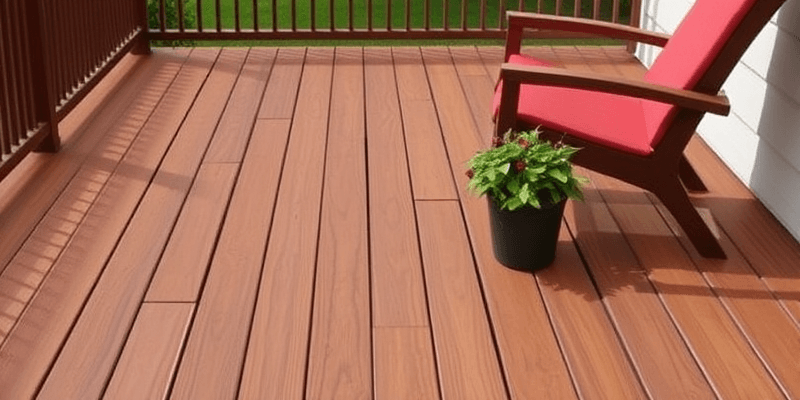Choosing Composite Decking That Mimics Real Wood: A Comprehensive Guide
Introduction
As homeowners seek to enhance their outdoor spaces, the choice of decking material becomes a pivotal decision. Composite decking, known for its durability and low maintenance, has gained immense popularity in recent years. However, not all composite decking products are created equal, especially when it comes to mimicking the aesthetic appeal of real wood. This guide will delve into the textures and finishes available in composite decking that emulate the beauty of natural wood, helping you make an informed choice for your next decking project.
The Benefits of Composite Decking
Before we explore the various textures and finishes that composite decking offers, it’s important to understand why so many homeowners are choosing this material over traditional wood. Here are some key benefits:
- Durability: Composite decking is resistant to rot, warping, and insect damage, making it an ideal choice for sustained outdoor use.
- Low Maintenance: Unlike wood, composite decking does not require regular staining or sealing, simply a wash with soap and water is sufficient to maintain its appearance.
- Environmental Impact: Many composite decking products are made from recycled materials, contributing to sustainability efforts.
Understanding Textures in Composite Decking
One of the most compelling aspects of composite decking that seeks to mimic real wood is its diverse range of textures. These textures play a critical role in both the aesthetic appeal and functionality of the decking.
1. Wood Grain Patterns
Many composite decking manufacturers create boards that feature embossed wood grain patterns. These grain patterns can range from subtle to pronounced, replicating the look of different types of hardwood. Look for options that offer a multi-directional grain design, as this can add realism and depth to your decking.
2. Rough vs. Smooth Finishes
Textures can also vary from rough to smooth finishes. While smooth surfaces are easier to clean and maintain, rougher textures tend to provide more grip, which can be advantageous in wet conditions. Consider how you plan to use your deck before deciding on a finish.
3. Hand-Scraped Effects
Some brands offer hand-scraped effects that further mimic the imperfections found in natural wood. These surfaces can add character and a rustic flair to your outdoor space, making it an attractive option for traditional-style homes.
4. Distressed Finishes
Distressed finishes replicate weathered wood, complete with the natural signs of aging and wear. This option can create a charming, vintage look, ideal for coastal or lakefront properties.
Finishes: Color and Protection
The finish of your composite decking is as important as its texture. While some textures focus on aesthetic appeal, finishes can protect your investment from the elements and enhance its longevity.
1. UV Resistance
Choose composite decking with finishes that offer UV protection. This feature helps prevent fading, allowing the color to maintain its vibrancy despite prolonged sun exposure. Check for warranties that guarantee color retention over time.
2. Stain Resistance
Opt for finishes that are resistant to staining. This feature is particularly important if you plan to host barbecues or gatherings where food and drink might be spilled. Look for composite decking that includes a protective layer specifically designed to repel stains.
3. Natural Color Options
Many manufacturers offer color options that closely mimic natural wood species, such as oak, mahogany, or cedar. Consider sustainable shades that blend well with your landscaping and home architecture, enhancing your outdoor space’s overall look.
4. Extruded Surface Treatments
Some composite decking products utilize special surface treatments during manufacturing to enhance durability and aesthetics. These treatments can provide a better grip and additional resistance to wear, ensuring the decking looks new for longer.
Choosing the Right Manufacturer
With numerous options on the market, selecting the right brand is paramount. Here are a few factors to consider when looking for a reputable manufacturer:
1. Warranty and Guarantees
Most quality composite decking brands offer warranties that last from 10 to 50 years. A solid warranty reflects the manufacturer’s confidence in their product’s durability and performance. Ensure you understand the terms and conditions before making a decision.
2. Customer Reviews
Always seek customer feedback on the specific product you intend to purchase. Online reviews and testimonials can provide insights into the performance and satisfaction levels experienced by other homeowners.
3. Eco-Friendly Certifications
If sustainability is important to you, check for eco-friendly certifications such as the Forest Stewardship Council (FSC) label that indicates responsible sourcing and minimal environmental impact.
4. Product Samples
Request samples of different textures and finishes from manufacturers. This enables you to see and feel the actual products before making a purchase, allowing for a better-informed decision.
Final Considerations
Choosing composite decking that mimics real wood doesn’t have to be a daunting task. By understanding the variety of textures and finishes available, you can create an outdoor space that reflects your style and accommodates your needs. Remember to prioritize quality, durability, and design when making your selection.
Conclusion
Composite decking offers an attractive and sustainable option for homeowners looking to enhance their outdoor spaces. By carefully considering textures and finishes, you can choose a product that not only looks like real wood but also provides the benefits of durability and low maintenance. Take the time to explore your options, consult reviews, and select a reputable manufacturer to enjoy your new deck for years to come.

